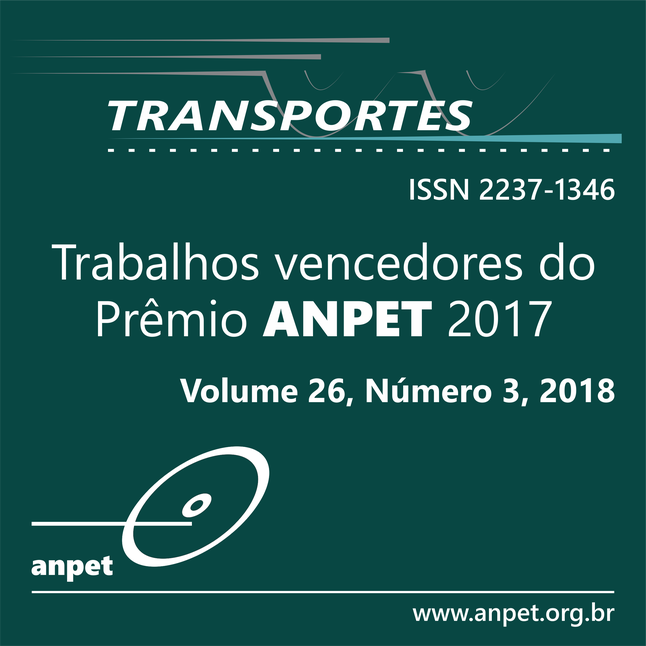Influência do modo de aplicação de carga nas propriedades de fratura de uma mistura asfáltica de agregados finos
DOI:
https://doi.org/10.14295/transportes.v26i3.1609Keywords:
Asphalt mixtures, Fracture properties, Cohesive zone model, Numerical simulations.Abstract
Among the different distresses that compromise the service life of asphalt mixtures, cracking is probably one of the most complexes and hard to be predicted. The cracking resistance of such materials is highly dependent of temperature and loading conditions. In this study, it was investigated the effects of loading conditions on the fracture parameters of a fine aggregate asphalt mixture, determined from simulations of semi-circular bending (SCB) tests. The SCB simulations were performed using the finite element method and the bilinear cohesive zone model, considering only the fracture mode I and three different loading configurations. The results (fracture energy, cohesive strength and Force-CTOD curves) demonstrated that the loading configuration exerts a significant influence on the fracture parameters and, consequently, on the applicability of this type of numerical-experimental procedure.Downloads
References
Aragão, F. T. S. e Kim, Y. R. (2012). Mode I fracture characterization of bituminous paving mixtures at intermediate service temperatures. Experimental Mechanics, v. 52, n. 9, p. 1423-1434. DOI: 10.1007/s11340-012-9594-4.
Aragão, F. T. S.; D. A. Hartmann; Y. R. Kim; L. M. G. Motta e M. Haft-Javaherian (2014). A numerical-experimental approach to characterize fracture properties of asphalt mixtures at low in-service temperatures. Transportation Research Record: Journal of the Transportation Research Board. Washington, D.C., n. 2447, p. 42-50. DOI: 10.3141/2447-05.
Budny, J. (2012). Avaliação do comportamento mecânico de misturas asfálticas mornas. Dissertação (Mestrado em Engenharia Civil). COPPE/UFRJ. Rio de Janeiro, Brasil.
Hirsch, F. (2009). Avaliação das propriedades de misturas asfálticas através do ensaio de tração em disco circular com fenda. (Mestrado em Engenharia Civil). COPPE/UFRJ. Rio de Janeiro, Brasil.
Li, X. e M. O. Marasteanu (2004). Evaluation of the low temperature fracture resistance of asphalt mixtures using the semi circular bend test. Journal of the Association of Asphalt Paving Technologists, v. 73, p. 401-426. ISSN: 0270-2932
Li, X e M. O. Marasteanu (2010). Using semi circular bending test to evaluate low temperature fracture resistance for asphalt concrete. Experimental Mechanics, Inc., v. 50, p. 867-876. DOI: 10.1007/s11340-009-9303-0.
Marasteanu, M. O.; S. T. Dai; J. F. Labuz e X. Li (2002). Determining the low-temperature fracture toughness of asphalt mix-tures. In Transportation Research Record: Journal of the Transportation Research Board, n. 1789, p. 191-199. DOI: 10.3141/1789-21.
Marasteanu, M. O.; W. Buttlar; H. Bahia e C. Williams (2012). Investigation of low temperature cracking in asphalt pavements, National Pooled Fund Study -Phase II. Final Report MN/RC 2012-23. Minnesota Department of Transportation. Minnesota, Estados Unidos.
Song, S.H.; G. H. Paulino e W. G. Buttlar (2006). A bilinear cohesive zone model tailored for fracture of asphalt concrete con-sidering viscoelastic bulk material. J. of Engineering Fracture Mechanics, p. 2829-2847. DOI: 10.1016/j.engfracmech.2006.04.030.
Song, S. H.; M. P. Wagoner e G. H. Paulino (2008). δ25 Crack opening displacement parameter in cohesive zone models: ex-periments and simulations in asphalt concrete. Fatigue and Fracture of Engineering Materials & Structures, n. 31, p. 850-856. DOI: 10.1111/j.1460-2695.2008.01272.x.
Sousa, P.; E. Kassen; E. Masad e D. Little (2013). New design method of fine aggregates mixtures and automated method for analysis of dynamic mechanical characterization data. Construction and Building Materials, n. 41, p. 216-223. DOI: 10.1016/j.conbuildmat.2012.11.038.
Wagoner, M. P.; W. G. Buttlar; G. H. Paulino e P. Blankenship (2005). Investigation of the fracture resistance of hot-mix asphalt concrete using a disk-shaped compact tension test. TRR, n. 1929, p. 183-192. DOI: 10.1177/0361198105192900122.
Downloads
Published
How to Cite
Issue
Section
License
Authors who submit papers for publication by TRANSPORTES agree to the following terms:
- The authors retain the copyright and grant Transportes the right of first publication of the manuscript, without any financial charge, and waive any other remuneration for its publication by ANPET.
- Upon publication by Transportes, the manuscript is automatically licensed under the Creative Commons License CC BY 4.0 license. This license permits the work to be shared with proper attribution to the authors and its original publication in this journal.
- Authors are authorized to enter into additional separate contracts for the non-exclusive distribution of the version of the manuscript published in this journal (e.g., publishing in an institutional repository or as a book chapter), with recognition of the initial publication in this journal, provided that such a contract does not imply an endorsement of the content of the manuscript or the new medium by ANPET.
- Authors are permitted and encouraged to publish and distribute their work online (e.g., in institutional repositories or on their personal websites) after the editorial process is complete. As Transportes provides open access to all published issues, authors are encouraged to use links to the DOI of their article in these cases.
- Authors guarantee that they have obtained the necessary authorization from their employers for the transfer of rights under this agreement, if these employers hold any copyright over the manuscript. Additionally, authors assume all responsibility for any copyright infringements by these employers, releasing ANPET and Transportes from any responsibility in this regard.
- Authors assume full responsibility for the content of the manuscript, including the necessary and appropriate authorizations for the disclosure of collected data and obtained results, releasing ANPET and Transportes from any responsibility in this regard.










